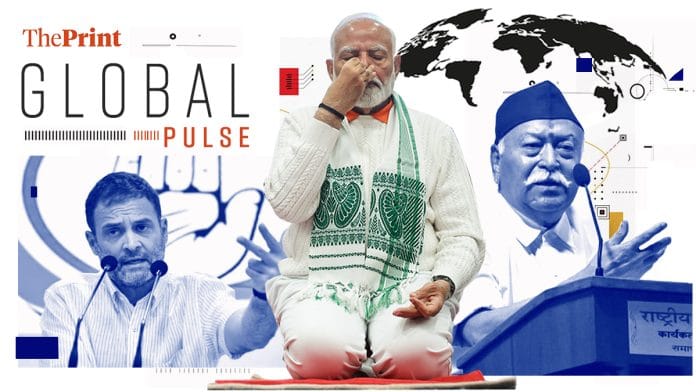New Delhi: Amid reports of a “weakened” Narendra Modi after the Lok Sabha polls setback — the BJP failed to get a majority and had to rely on a coalition to stay in power at the Centre — The Economist has taken up the cause of the prime minister’s stress. Talking about an “unusually public rift” between the BJP and the Rashtriya Swayamsevak Sangh (RSS), the “hurried” recalibration of the Budget to appease the youth, and ally Sheikh Hasina’s ouster as Bangladesh prime minister, an op-ed piece suggests that Modi may have to resort to some “extra asanas” to relieve stress.
The BJP’s assertion of now being “capable” of “running itself” and the upcoming selection of a new party president, amid the RSS’ criticism of its election strategy, are two major concerns between the two, the piece says. The RSS, which is the ideological parent of the BJP, is also the machinery on the ground that spreads its message across. With over 73,000 cells, the Sangh has also given the party many of its top leaders.
Testy exchanges have followed after the “the balance of power in the Hindutva movement” seemingly shifted towards Modi and Amit Shah, who are “increasingly unreceptive to advice or criticism”. Concessions are being made, the piece notes, as it points out the finance minister’s “consultation” with the Swadeshi Jagran Manch — the RSS’ economic wing — before the release of the Budget and the lifting of a 58-year-old ban on civil servants being RSS members, giving the organisation clout in the bureaucracy.
Jumping on the bandwagon, Sadanand Dhume writes in the Wall Street Journal that Modi is starting to look weak, in a piece headlined ‘Modi Loses His Mojo as He Bows to the Opposition’. Dhume talks about the rollback of ads for lateral entry in bureaucracy. While noting that the government “during previous terms recruited dozens of outside experts without fuss”, he says that the rollback “suggests that the ruling Bharatiya Janata Party’s loss of its single-party majority in June has diminished the prime minister’s appetite for reform”.
Calling the policy “perfectly defensible”, Dhume claims that Modi’s U-turn “isn’t smart” as he had allowed the Opposition and Rahul Gandhi to control the narrative. “A recent poll by India Today shows that only 49% of Indians see Mr. Modi as the best choice for prime minister, the lowest percentage in three years. Mr. Gandhi’s rating, by contrast, has risen nearly 9 points, to 22.4%, over the past six months,” Dhume notes.
The Financial Times recognises a shift in the Indian equity market as “foreign investors pull out” contradicting the strong surge in domestic markets. “Year to date inflows stood at $2.6bn, well below the $22bn recorded last year,” “with net outflows of more than $1bn,” Arjun Neil Alim and Chris Kay note in their piece.
While “the country’s large internal market and rapid economic growth also insulated it from steep US interest rate rises in 2022 and 2023, which helped to pull money from many emerging markets,” and investors shifted their eye toward India as they “ sought returns outside China”, “global investors are warning over its lofty valuations as retail investors have piled into the market”. India’s equity market cycle, the paper notes, is dominated by domestic investors, many of whom have no understanding of the “risks”.
A Global Times piece argues that a protectionist trend is underway in the US and has started to impact Indian manufacturers. While “India’s exports of electronics goods to the US have surged quickly”, the “Indian solar panels are facing US scrutiny for possible links to so-called ‘forced labor’ in China”.
The editorial claims that the targeting of China’s manufacturing on which India depends is just a facade to ensure the competitiveness of American companies and the economy.
According to industry analysis by Global View Research, “The U.S. solar PV market size was estimated at USD 29.68 billion in 2022 and is projected to grow at a compound annual growth rate (CAGR) of 13.7% from 2023 to 2030.”
Rollo Romig reports for the New York Times from Vapi about Indian-born video games that have caught the international eye. Jamin Warren, who runs an LA gallery for video game art, displayed a game inspired by the Bhima Koregaon political prisoners. Another is inspired by the Babri Masjid demolition, while in another, the user can play as a “municipal building eater who has been hired by a government agency to literally consume, piece by piece, a ceramic tower that is the only edifice left standing in your town’s barren landscape”.
In a piece titled ‘Critiquing India’s Politics With Absurdist Games’, Romig addresses these and other games that are inspired by architecture, art installation, and even relics as young Indian coders, designers, and writers from Maharashtra, Gujarat, and Goa boast their creations. The colour and scale of the graphics in these games are what caught international attention alongside how local tales and poetry find an unmissable space in these creations.
Also Read: Global media on Modi’s ‘wait-and-see’ Ukraine strategy & transformation into ‘expert on U-turns’
New details on Trump assassination attempt
The FBI has made public a set of findings on the attempted assassination of former president Donald Trump. CNN reports about the weapon used and NYT delves into 20-year-old Thomas Crooks’s long-held interest in acts of public violence. Read CNN and NYT’s coverage.
Toyota’s 28 production lines and 14 factories in Japan have halted production owing to the perceived impact of Typhoon Shanshan. Emergency warnings are underway in Miyazaki, Kagoshima, and Ehime prefectures in Japan’s far southwest. To know more about the typhoon and its impact, read the Washington Post and Nikkei Asia’s reports.
(Edited by Gitanjali Das)
Also Read: What do NYT, WaPo, Economist, Guardian, FT write about Modi’s India? Just read ‘Global Pulse’






